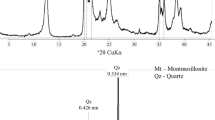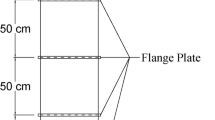Abstract
Dripper clogging is a major drawback of microirrigation systems that must be addressed to improve their efficiency and durability. Particle-induced clogging is first studied in situ. The experiments consist in observing in real conditions the behavior of a series of drippers fitted on an agricultural plot in the south of France. The plot is supplied from a canal with Durance River water. The latter is loaded with sediments that gradually clog drippers and filters. Water analysis reveal that physicochemical clogging prevails over biological clogging. This characterization helps in setting in-lab experiment protocol. Indeed, besides field observation of clogging, laboratory analyses of both the irrigation water and the clogging material are performed with reactive and inert clay: smectite and an illite–calcite mix. A surprising tendency is observed: Salt concentration in smectite seeded water decreases the clogging, whereas it increases agglomerate size. Computational fluid dynamic simulations are carried out to investigate the impact of particles on flow behavior. Results demonstrate that clay particles interacting with the flow govern the complex structure of the fluid velocity fields inside the dripper labyrinth channel.


















Similar content being viewed by others
References
Abend S, Lagaly G (2000) Dsol-gel transitions of sodium montmorillonite dispersions. Appl Clay Sci 16(34):201–227
Adin A, Sacks M (1991) Dripper-clogging factors in wastewater irrigation. J Irrig Drain Eng 117:813–826
Bounoua S (2010) Etude du colmatage des systèmes d’irrigation localisée. PhD thesis, Aix-Marseille University
Capra A, Scicolone B (1998) Water quality and distribution uniformity in drip/trickle irrigation systems. J Agric Eng Res 70(4):355–365
Chossat J (1995) Entretient en micro-irrigation, vol 19, 2e edn., Collection étude du Cemagref serie Equipement pour l eau et l environnement, Antony
Dazhuang Y, Peiling Y, Shumei R, Yunkai L, Tingwu X (2007) Numerical study on flow property in dentate path of drip emitters. N Zeal J Agric Res 50:705–712
Gilbert R, Nakayama F, Bucks D, French O, Adamson K (1981) Trickle irrigation: emitter clogging and other flow problems. Agric Water Manag 3:159–178
Hetsroni G, Mosyak A, Pogrebnyak E, Yarin L (2005) Fluid flow in micro-channels. Int J Heat Mass Transf 48:1982–1998
Hills D, Nawaar F, Waller P (1989) Effects of chemical clogging on drip-tape uniformity. Trans ASAE 32(4):1202–1206
Karmeli D (1977) Classification and flow regime analysis of drippers. J Agric Eng Res 22:165–173
Kulick J, Fessler J, Eaton J (1994) Particle response and turbulence modification in fully developed channel flow. J Fluid Mech 277:109–134
Labille J, Thomas F, Bihannic I, Santaella C (2003) Destabilization of montmorillonite suspensions by Ca\(^2+\) and succinoglycan. Clay Miner 38:173–185
Levy G, Fine P, Bart-Tal A (2011) Treated wastewater in agriculture: use and impacts on the soil environments and crops. Wiley-Blackwell, Hoboken
Li H, Olsen M (2006) Micropiv measurements of turbulent flow in square microchannels with hydraulic diameters from 200 \(\mu\)m to 640 \(\mu\)m. Int J Heat Fluid Flow 27:123–134
Lin K, Yang J (2007) Chaotic mixing of fluids in a planar serpentine channel. Int J Heat Mass Transf 50:1269–1277
Luo H (1993) Coalescence, breakup and liquid circulation in bubble column reactors. Ph.D. thesis, Norwegian Institute of Technology, Trondheim, Norway
Nakayama F, Bucks D (1991) Water quality in drip/trickle irrigation. Irrig Sci 12:187–192
Niu W, Liu L, Chen X (2013) Influence of fine particle size and concentration on the clogging of labyrinth emitters. Irrig Sci 31:545–555
Pfund D, Rector D, Shekarriz A (2000) Pressure drop measurements in a microchannel. Fluid Mech Transp Phenom 46(8):1496–1507
Pitts D, Haman D, Smajstra A (1990) Causes and prevention of emitter plugging in microirrigation systems, Florida Cooperative Extension Service Bulletin, vol 258. University of Florida, Florida
Qingsong W, Gang L, Jie L, Yusheng S, Wenchu D, Shuhuai H (2008) Evaluations of emitter clogging in drip irrigation by two-phase flow simulations and laboratory experiments. Comput Electron Agric 63:294–303
Qu W, Mudawar I (2002) Experimental and numerical study of pressure drop and heat transfer in a single-phase micro-channel heat sink. Int J Heat Mass Transf 45:2549–2565
Quirk J, Schofield R (1955) The effect of electrolyte concentration on soil permeability. J Soil Sci 6(2):163–178
Ravina I, Paz E, Sofer Z, Marcu A, Schisha A, Sagi G (1992) Control of emitter clogging in drip irrigation with reclaimed wastewater. Irrig Sci 13:129–139
Santiwong S, Guan J, Waite T (2008) Effect of ionic strength and ph on hydraulic properties and structure of accumulating solid assemblages during microfiltration of montmorillonite suspensions. J Colloid Interface Sci 317(1):214–227
Sharp K, Adrian R (2004) Transition from laminar to turbulent flow in liquid filled microtubes. Exp Fluids 36:741–747
Stawinski J, Wierzchos J, Garcia-Gonzalez M (1990) Influence of calcium and sodium concentration on the microstructure of bentonite and kaolin. Clays Clay Miner 38(6):617–622
Vreman A (2007) Turbulence characteristics of particle-laden pipe flow. J Fluid Mech 584:235–279
Wei Q, Yusheng S, Wenchu D, Gang L, Shuhuai H (2006) Study on hydraulic performance of drip emitters by computational fluid dynamics. Agric Water Manag 84:130–136
Wei Z, Cao M, Liu X, Tang Y, Lu B (2012) Flow behaviour analysis and experimental investigation for emitter micro-channels. Chin J Mech Eng 25:729–737
Wu P, Little W (1983) Measurement of friction factor for flow of gases in very fine channels used for micro-miniature Joule Thompson refrigerators. Cryogenics 23:273–277
Yuan Z, Michaenidies E (1992) Turbulence modulation in particle flows—a theoretical approach. Int J Multiph Flow 18(15):779–785
Acknowledgments
This work has been funded by the Region Provence-Alpes-Cotes d’Azur and IRSTEA, the National Research Institute of Science and Technology for Environment and Agriculture.
Author information
Authors and Affiliations
Corresponding author
Additional information
Communicated by N. Lazarovitch.
Rights and permissions
About this article
Cite this article
Bounoua, S., Tomas, S., Labille, J. et al. Understanding physical clogging in drip irrigation: in situ, in-lab and numerical approaches. Irrig Sci 34, 327–342 (2016). https://doi.org/10.1007/s00271-016-0506-8
Received:
Accepted:
Published:
Issue Date:
DOI: https://doi.org/10.1007/s00271-016-0506-8




